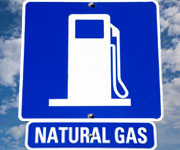A version of this article originally appeared on Climate Progress.
 The International Energy Agency (IEA) has a new report out, “Golden Rules for a Golden Age of Gas” [PDF]. Unfortunately, the IEA buried the lede — the Golden Age of Gas scenario destroys a livable climate — so the coverage of the report was off target.
The International Energy Agency (IEA) has a new report out, “Golden Rules for a Golden Age of Gas” [PDF]. Unfortunately, the IEA buried the lede — the Golden Age of Gas scenario destroys a livable climate — so the coverage of the report was off target.
For instance, The New York Times opines, “Energy Agency Finds Safe Gas Drilling is Cheap.” And the Council on Foreign Relations headline is similar: “Safe Fracking Looks Cheap.”
That’s true only if a ruined climate, widespread Dust Bowlification, an acidified ocean, and rapidly rising sea levels constitute your idea of “safe.”
Still, the IEA deserves much of the blame for this miscoverage. It’s not until page 91 (!) of the full report [PDF] that the agency explains that adopting its “Golden Rules” for developing shale gas doesn’t stop catastrophe:
The Golden Rules Case puts CO2 emissions on a long-term trajectory consistent with stabilizing the atmospheric concentration of greenhouse-gas emissions at around 650 parts per million, a trajectory consistent with a probable temperature rise of more than 3.5 degrees C [6.3 degrees F] in the long term, well above the widely accepted 2 degrees C [3.6 degrees F] target. This finding reinforces a central conclusion from the WEO special report on a Golden Age of Gas (IEA, 2011b), that, while a greater role for natural gas in the global energy mix does bring environmental benefits where it substitutes for other fossil fuels, natural gas cannot on its own provide the answer to the challenge of climate change.
D’oh! Or is that duh?
The IEA was far clearer and blunter when it released its original report, as I wrote last year. At the time, the Guardian story put it well:
At such a level, global warming could run out of control, deserts would take over in southern Africa, Australia and the western U.S., and sea level rises could engulf small island states.
Not exactly a champagne moment.
Also, it’s far from clear that 650 parts per million (ppm) is even stable, in the sense of not triggering carbon cycle feedbacks that cause further warming — or not crossing dangerous tipping points.
If we risk warming beyond 3.5 degrees C, we are courting multiple, simultaneous disasters. Such warming is “incompatible with organized global community, is likely to be beyond ‘adaptation,’ is devastating to the majority of ecosystems, and has a high probability of not being stable (i.e. 4 degrees C would be an interim temperature on the way to a much higher equilibrium level),” according to professor Kevin Anderson, director of the Tyndall Center for Climate Change in Britain (see here).
Also, the IEA scenario assumes coal use is basically flat from 2020 to 2035, which the report makes pretty clear would require a price on carbon. Without a carbon price, natural gas is a brige to nowhere and can actually crowd out carbon-free sources of power. That was precisely the point made by Nobuo Tanaka, executive director of the IEA, at a London press conference for the 2011 report:
While natural gas is the cleanest fossil fuel, it is still a fossil fuel. Its increased use could muscle out low-carbon fuels such as renewables and nuclear, particularly in the wake of Fukushima. An expansion of gas use alone is no panacea for climate change.
The Guardian focused on the crowding effect for its piece Tuesday on the new report, “‘Golden age of gas’ threatens renewable energy, IEA warns.”
To be clear, the “Golden Rules” proposed by the IEA still lead to a 20 percent rise in energy-related CO2 emissions from 2010 to 2035, a time we need to be slashing global CO2 levels. As climatologist Ken Caldeira told me in March, natural gas is “a bridge to a world with high CO2 levels.”
Oh, and there’s a mini-bombshell that the IEA sticks in a footnote when discussing options for avoiding the 3.5-plus degrees C warming:
This conclusion could be changed by widespread application of technologies such as carbon capture and storage, which could reduce considerably the emissions from the consumption of gas (and other fossil fuels); but this is not assumed in the period to 2035.
It’s wise not to assume much carbon capture and storage (CCS) by 2035 given the unresolved feasibility, permanence, and safety issues surrounding CCS as well as the fact that CCS efforts around the world are being scaled back or terminated.
But here’s the footnote:
There is the possibility that the capacities for CO2 storage might be affected by hydraulic fracturing. A recent study (Elliot and Celia, 2012) estimated that 80% of the potential area to store CO2 underground in the United States could be prejudiced by shale and tight gas development, although others have argued that, even if the rock seal in one place were to be broken by hydraulic fracturing, other layers of impermeable rock underneath the fractured area would block migration of the CO2.
Yeow!
I’d been meaning to blog on that study, “Potential Restrictions for CO2 Sequestration Sites Due to Shale and Tight Gas Production.” No, this study doesn’t mean fracking will wipe out all potential CCS storage areas. But it does suggest that an all-out fracking spree — aka the Golden Age of Gas Scenario aka GAGS — will constrict our storage options in the future.
Finally, on my 2011 post on GAGS, Tyler Hamilton, business columnist at The Toronto Star, commented:
Not only is gas threatening to crowd out renewables, cheap natural gas — viewed as an input fuel — is dramatically improving the economics for unconventional oil. More cheap gas means more dirty oil. Not a good combination.
The bottom line is that if your goal is to stay under or as close to 4 degrees F warming as possible, then we can’t be investing significant resources in new fossil fuel infrastructure — especially without a high and rising CO2 price.



